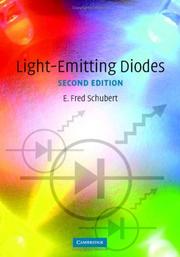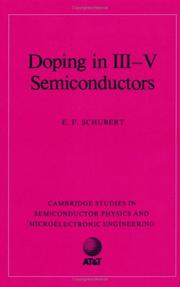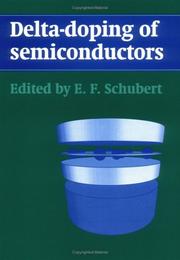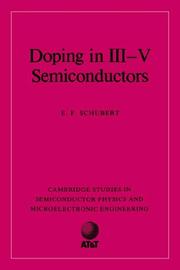| Listing 1 - 8 of 8 |
Sort by
|
Book
ISBN: 0819424137 Year: 1997 Publisher: Bellingham SPIE
Abstract | Keywords | Export | Availability | Bookmark
 Loading...
Loading...Choose an application
- Reference Manager
- EndNote
- RefWorks (Direct export to RefWorks)
Conferences - Meetings --- Light emitting diodes --- Semiconductors --- Congresses. --- Congresses

ISBN: 9780521865388 0521865387 9780511790546 Year: 2014 Publisher: Cambridge: Cambridge university press,
Abstract | Keywords | Export | Availability | Bookmark
 Loading...
Loading...Choose an application
- Reference Manager
- EndNote
- RefWorks (Direct export to RefWorks)
Revised and fully up-dated, the second edition of this graduate textbook offers a comprehensive explanation of the technology and physics of LEDs such as infrared, visible-spectrum, ultraviolet, and white LEDs made from III-V semiconductors. Elementary properties such as electrical and optical characteristics are reviewed, followed by the analysis of advanced device structures. With nine additional chapters, the treatment of LEDs has been vastly expanded, including new material on device packaging, reflectors, UV LEDs, III-V nitride materials, solid-state sources for illumination applications, and junction temperature. Radiative and non-radiative recombination dynamics, methods for improving light extraction, high-efficiency and high-power device designs, white-light emitters with wavelength-converting phosphor materials, optical reflectors, and spontaneous recombination in resonant-cavity structures are discussed in detail. With exercises, solutions, and illustrative examples, this textbook will be of interest to scientists and engineers working on LEDs and graduate students in electrical engineering, applied physics, and materials science.
Light emitting diodes. --- 621.382.2 --- Dioden --- Crystal diodes --- 621.382.2 Crystal diodes --- LED (light emitting diode) --- Light emitting diodes --- Fysica --- 621.382 --- 621.382 Electronic devices using solid-state effects. Semiconductor devices --- Electronic devices using solid-state effects. Semiconductor devices --- LEDs (Light emitting diodes) --- Diodes, Semiconductor --- Electroluminescent devices --- LED lamps --- Light-emitting electrochemical cells --- Electronics and optics of solids --- Electronics
Book
ISBN: 1316789136 0511078617 0511077041 9780511078613 9780511077043 Year: 2003 Publisher: Cambridge, Uk New York Cambridge University Press
Abstract | Keywords | Export | Availability | Bookmark
 Loading...
Loading...Choose an application
- Reference Manager
- EndNote
- RefWorks (Direct export to RefWorks)
This graduate textbook covers all aspects of the technology and physics of infrared, visible-spectrum, and white-light-emitting diodes (LEDs) made from III-V semiconductors. It reviews elementary properties of LEDs such as the electrical and optical characteristics.
Light emitting diodes. --- Light emitting diodes --- Electrical Engineering --- Electrical & Computer Engineering --- Engineering & Applied Sciences --- LEDs (Light emitting diodes) --- Diodes, Semiconductor --- Electroluminescent devices --- LED lamps --- Light-emitting electrochemical cells

ISBN: 0521419190 Year: 1993 Publisher: Cambridge : Cambridge university press,
Abstract | Keywords | Export | Availability | Bookmark
 Loading...
Loading...Choose an application
- Reference Manager
- EndNote
- RefWorks (Direct export to RefWorks)

ISBN: 0521482887 Year: 1996 Publisher: Cambridge : Cambridge university press,
Abstract | Keywords | Export | Availability | Bookmark
 Loading...
Loading...Choose an application
- Reference Manager
- EndNote
- RefWorks (Direct export to RefWorks)
Field-effect transistors. --- Molecular beam epitaxy. --- Semiconductor doping. --- Semiconductors --- Design and construction.
Book
ISBN: 051159982X Year: 1993 Publisher: Cambridge : Cambridge University Press,
Abstract | Keywords | Export | Availability | Bookmark
 Loading...
Loading...Choose an application
- Reference Manager
- EndNote
- RefWorks (Direct export to RefWorks)
This is the first book to describe thoroughly the many facets of doping in compound semiconductors. Equal emphasis is given to the fundamental materials physics and to the technological aspects of doping. The author describes in detail all the various techniques, including doping during epitaxial growth, doping by implantation, and doping by diffusion. The key characteristics of all dopants that have been employed in III-V semiconductors are discussed. In addition, general characteristics of dopants are analyzed, including the electrical activity, saturation, amphotericity, auto-compensation and maximum attainable dopant concentration. The timely topic of highly doped semiconductors is discussed as well. Technologically important deep levels are summarized. The properties of deep levels are presented phenomenologically. The final chapter is dedicated to the experimental characterization of impurities.
Book
ISBN: 1107169860 1282466852 9786612466854 0511790546 0511343531 0511644485 0511648294 0511344376 0511573324 0511343949 0511344767 Year: 2006 Publisher: Cambridge ; New York : Cambridge University Press,
Abstract | Keywords | Export | Availability | Bookmark
 Loading...
Loading...Choose an application
- Reference Manager
- EndNote
- RefWorks (Direct export to RefWorks)
Revised and fully updated, the second edition of this graduate textbook offers a comprehensive explanation of the technology and physics of LEDs such as infrared, visible-spectrum, ultraviolet, and white LEDs made from III-V semiconductors. Elementary properties such as electrical and optical characteristics are reviewed, followed by the analysis of advanced device structures. With nine additional chapters, the treatment of LEDs has been vastly expanded, including new material on device packaging, reflectors, UV LEDs, III-V nitride materials, solid-state sources for illumination applications, and junction temperature. Radiative and non-radiative recombination dynamics, methods for improving light extraction, high-efficiency and high-power device designs, white-light emitters with wavelength-converting phosphor materials, optical reflectors, and spontaneous recombination in resonant-cavity structures are discussed in detail. With exercises, solutions, and illustrative examples, this textbook will be of interest to scientists and engineers working on LEDs and graduate students in electrical engineering, applied physics, and materials science.

ISBN: 9780511599828 9780521419192 9780521017848 Year: 1993 Publisher: Cambridge Cambridge University Press
Abstract | Keywords | Export | Availability | Bookmark
 Loading...
Loading...Choose an application
- Reference Manager
- EndNote
- RefWorks (Direct export to RefWorks)
| Listing 1 - 8 of 8 |
Sort by
|

 Search
Search Feedback
Feedback About UniCat
About UniCat  Help
Help News
News